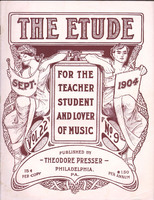BY DR. WILIBALD NAGEL.
FROM THE GERMAN BY FLORENCE LEONARD.
What is a sonata? The question is shorter to ask than to answer. To follow all the changes in the significance of the word, several centuries old, requires time. We will consider it briefly.
In the first place, sonata meant a composition performed by instruments only, and was used as the opposite of cantata, which meant something sung. Next, as musical expression developed further, it was necessary to distinguish between music of religious character and secular music. So in the seventeenth century we hear of sonata da camera and sonata da chiesa. But the sharp distinction between the two did not last very long and movements from one were used for the other, till polyphonic writing alternating with dance-forms made up a single work.
It was the predecessor of J. S. Bach, at St. Thomas’s, Joh. Kuhnau (1667-1722), who adapted the sonata da camera to the klavier. But the style of his sonatas is not yet that of the followers of Bach. For the great genius of Bach carried the art of polyphony to such marvelous heights of perfection that nothing remained for his followers but to strike out in new paths or fall into empty formalism. “In new paths,” I have said, but they were not entirely new, for the rococo style which followed can be found also in Bach’s writings. Among many contemporaries the name of Philipp Emanuel Bach is especially associated with the elaborate rococo writing, which did not confine itself strictly to any given number of parts. It developed first in France, and then the French pieces were imitated in Germany.
But when this style of writing had passed under the influence of German thought it resulted in music of quite a new character, and this new influence we must assign to Domenico Scarlatti. It would be too much to say that his music was entirely homophonic, that is, consisting of one melody-voice, with other accompanying voices; but very much of it does present that characteristic, which is quite the opposite of its polyphonic forerunners in which all the voices were of approximately equal value. One more point must be noticed here,—that the form of the sonata was in two parts, and that the sonata itself was only in one movement. From this time dates the developing process of the real sonata, and the names which lead by gradual steps to it are J. S. Bach, Chr. Graupner, Fasch, the Mannheim School, Philipp Emanuel Bach, Johann Christoph Bach, Haydn, and Mozart.
The result of the lifework of these men was that the sonata finally took a certain permanent form. The first movement was distinguished by two themes. These themes were contrasted in rhythm and key, and joined together according to certain rules. These two themes and the ones spun out from them dominated the whole first division of the movement, and so strongly that after the second theme had been given out it led on to the ending, in its own key, and that led to a repetition of the first division.
Then followed another division. Its beginning was marked by the double bar. This was called the development, or working out. In the early forms (with Graupner and others) it was written after the fashion of fugues, of which one of the laws was that the theme should be answered or imitated a fifth above. But when the freer style of writing was in use that strict imitation had to be abandoned. Furthermore the attempt was made to use parts of the theme instead of the whole, for the development, and to carry them into different keys, sometimes far away from the original one. In this division the climax of the piece was reached, and, like the ending of the first division, it led back to the first theme of the first division.
The new, or third, division was on that account called the reprise, or recapitulation. But it was seldom a mere repetition of the first division. On the contrary, it was adorned with all kinds of embellishments and little extensions of the thought.
These three divisions constitute the regular sonata form, in its first, strictly constructed, movement.
The other movements of a sonata follow each other in freer order, and are not so closely bound by laws of construction as the first, or sonata movement.



